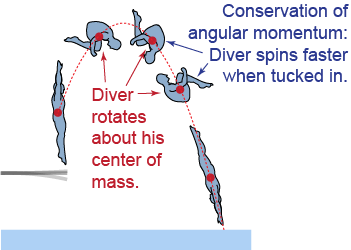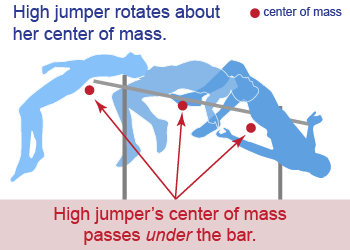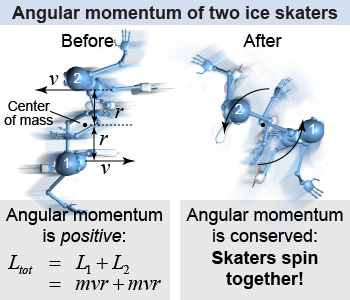|
Tumbling and spinning are key parts of many different sports. When athletes spin in the air or on ice, they rotate around their center of mass—which is typically located in the lower torso of a person when standing upright. Athletes may control their moment of inertia by tucking in their limbs; since angular momentum L = Iω is conserved, reducing the moment of inertia I leads to an increase in the athlete’s angular velocity ω. 
|
 An advanced diver may do several somersaults in the air. As he jumps off the diving board, he begins tumbling. By tucking his body in tightly, he will complete the somersaults more quickly—and he can do more of them before straightening out again and entering the water! Throughout the dive, his body rotates around his center of mass. The same technique is used in gymnastics, such as in performing multiple somersaults in midair in the vault event.
An advanced diver may do several somersaults in the air. As he jumps off the diving board, he begins tumbling. By tucking his body in tightly, he will complete the somersaults more quickly—and he can do more of them before straightening out again and entering the water! Throughout the dive, his body rotates around his center of mass. The same technique is used in gymnastics, such as in performing multiple somersaults in midair in the vault event. 
|
 In track and field, high jumpers rotate their bodies about their center of mass—and over the bar—using a technique called the “Fosbury flop,” named after American Dick Fosbury, the 1968 Olympics gold medalist. When the jump is properly executed, a high jumper’s center of mass actually passes under the bar, allowing the athlete to gain a little bit of extra height!
In track and field, high jumpers rotate their bodies about their center of mass—and over the bar—using a technique called the “Fosbury flop,” named after American Dick Fosbury, the 1968 Olympics gold medalist. When the jump is properly executed, a high jumper’s center of mass actually passes under the bar, allowing the athlete to gain a little bit of extra height! 
|
 Two figure skaters will “collide” with each other slightly offset—by an arm’s length—so that they lock arms and spin together afterward. Why do they spin around instead of collapsing in a heap, as they would in a head-on collision? As they come together, each has an angular momentum relative to their combined center of mass. Both skaters have angular momenta spinning in the same direction around the center of mass, so their angular momenta add, not cancel. Since their combined angular momentum is conserved, after the “collision” they will continue to spin about their mutual center of mass.
Two figure skaters will “collide” with each other slightly offset—by an arm’s length—so that they lock arms and spin together afterward. Why do they spin around instead of collapsing in a heap, as they would in a head-on collision? As they come together, each has an angular momentum relative to their combined center of mass. Both skaters have angular momenta spinning in the same direction around the center of mass, so their angular momenta add, not cancel. Since their combined angular momentum is conserved, after the “collision” they will continue to spin about their mutual center of mass. 
|
When an ice skater spins as part of a jump, what will he typically do with his arms right before and right after taking off?
 |
Right before taking off, the skater may have his arms outstretched, in order to have more angular momentum as he twists his body around. Right after taking off, he tucks his arms in, in order to increase the speed of rotation of his body—so that he can complete more turns! 
|
| |
|

